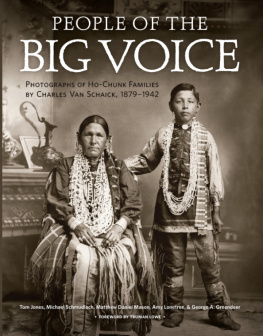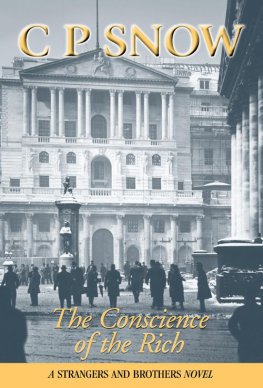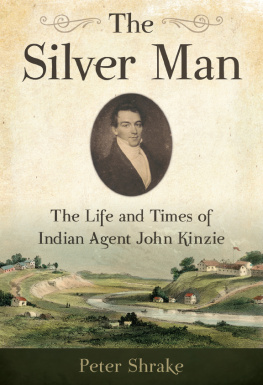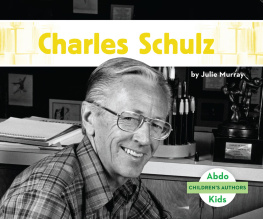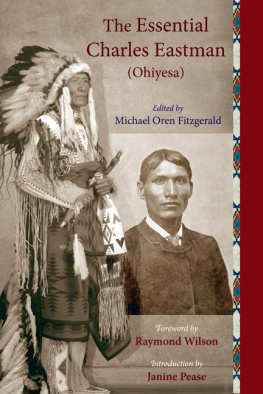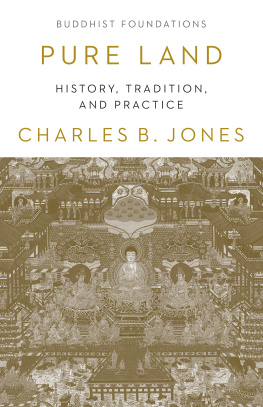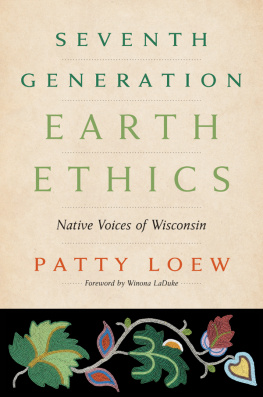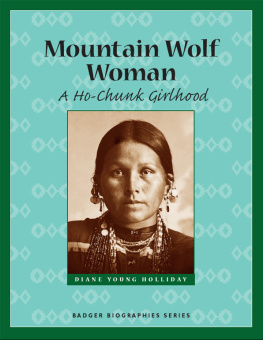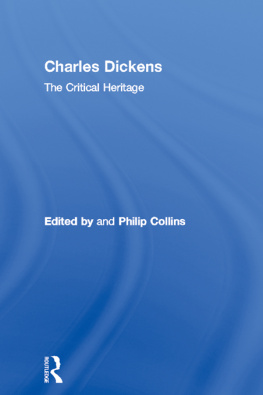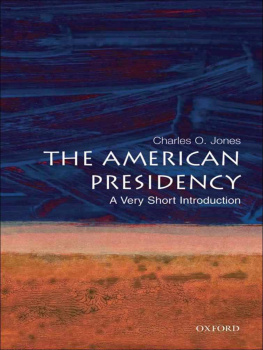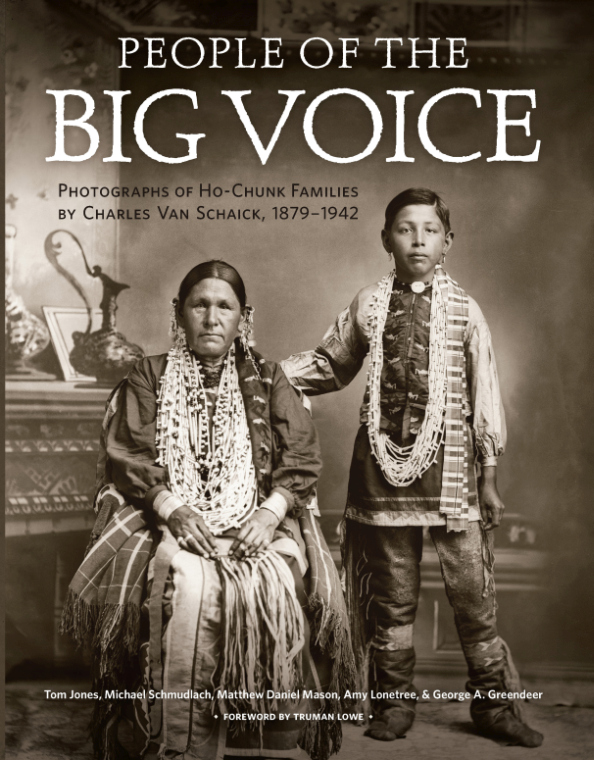
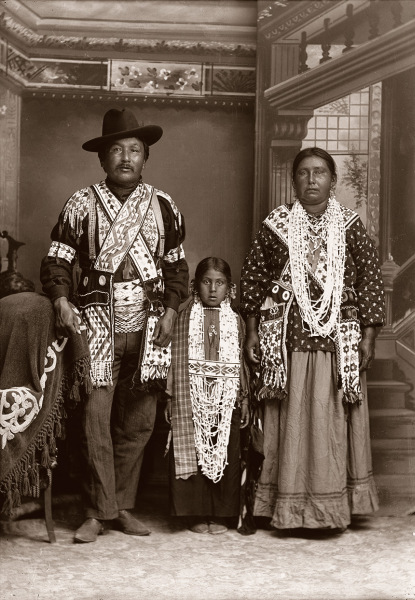
PEOPLE OF THE BIG VOICE
P HOTOGRAPHS OF H O- C HUNK F AMILIES
BY C HARLES V AN S CHAICK, 18791942
Tom Jones, Michael Schmudlach, Matthew Daniel Mason,
Amy Lonetree, & George A. Greendeer
W ISCONSIN H ISTORICAL S OCIETY P RESS
Publication of this book was made possible in part by a gift in memory of Allen Van Schaick.
Published by the Wisconsin Historical Society Press
Publishers since 1855
2011 by the State Historical Society of Wisconsin
E-book edition 2014
For permission to reuse material from People of the Big Voice (ISBN 978-0-87020-476-0, e-book ISBN: 978-0-87020-659-7), please access www.copyright.com or contact the Copyright Clearance Center, Inc. (CCC), 222 Rosewood Drive, Danvers, MA 01923, 9787508400. CCC is a not-for-profit organization that provides licenses and registration for a variety of users.
wisconsinhistory.org
Photographs identified with WHi are from the Societys collections; address requests to reproduce these photos to the Visual Materials Archivist at the Wisconsin Historical Society, 816 State Street, Madison, WI 53706, or by visiting , which constitutes a continuation of this copyright page.
The Library of Congress has cataloged the printed edition as follows:
Jones, Thomas L., 1964
People of the big voice: photographs of Ho-Chunk families by Charles Van Schaick, 18791942 / Tom Jones... [et al.].
p. cm.
Includes bibliographical references and index.
ISBN 978-0-87020-476-0 (hardcover: alk. paper) 1. Ho Chunk IndiansPortraits. 2. Ho Chunk IndiansPictorial works. 3. Portrait photographyWisconsinBlack River Falls. 4. Black River Falls (Wis.)HistoryPictorial works. 5. Van Schaick, CharlesPhotography collections. I. Title.
E99.W7J66 2011
305.897526dc22
201100431
Front cover: Susie Kingswan (HeNuKah) and her son Fred Kingswan (MaHeNoGinKah), ca. 1894. WHi Image ID 60862. The image appears in full on . Frontispiece: David Goodvillage (WauHeTonChoEKah), Lucy Blackhawk Bighead Davis Goodvillage (NeAhTakEWinKah), and Lucys granddaughter Mabel Blackhawk St. Cyr, ca. 1897. WHi Image ID 61508.
C ONTENTS
TRUMAN LOWE
Charles J. Van Schaick and His Photographs of the Ho-Chunk
MATTHEW DANIEL MASON
Encounters with My Ho-Chunk Ancestors in the Family Photographs of Charles Van Schaick
AMY LONETREE
TOM JONES
MICHAEL SCHMUDLACH
JANICE RICE
MICHAEL SCHMUDLACH
P EOPLE OF THE B IG V OICE documents a critical chapter in Americanand Ho-Chunkhistory. Despite numerous removals in the nineteenth century, some Ho-Chunk always returned to their beloved homeland in Wisconsin. The photographs taken by Charles Van Schaick and contained in this book document members of this community. They also record the Ho-Chunk Nations deep connection to the land of this region. Above all, they demonstrate the resilience of a people.
This book is also important for the balanced, multi-dimensional history it provides. In the first essay, historian Matthew Daniel Mason sketches the life of Charles Van Schaick, adding little-known details about the Black River Falls studio photographer. In tracing Van Schaicks ties to the community he photographed, Mason offers a perspective on the region that is markedly different from the psycho-sociological presentation Michael Lesy advanced in his book Wisconsin Death Trip in 1973.
Ho-Chunk historian Amy Lonetree in her essay uses personal family history to delineate the devastating effects of federal Indian removal policies on one Native American community.
In the final essay in this collection, Ho-Chunk photographer Tom Jones interprets the structure and organization of Van Schaicks photographs and offers some observations on the perceived relationship between the photographer and his customers/subjects.
I feel a special connection to Van Schaicks photographs because they depict the place where I grew up and individuals whose children and grandchildren I know. I am especially pleased with the contributions by Lonetree and Jones because, in addition to the information they contain, they represent instances in which Ho-Chunk are looking at, interpreting, and writing our own histories.
People of the Big Voice is the collaboration of many individuals who are committed to preserving the history of the Ho-Chunk. These photographs bring forth memories like carefully wrapped, stored items. Only when unwrapped do they reveal the cultural fabric of Ho-Chunk life. Because it captures the intersection of two cultures at a particular moment in time, this book is certain to become a valuable resource. Most important, it provides evidence of the endurance of community.
Truman Lowe
WaKaJaHunkKah (King of Thunder)
Professor Emeritus of Art, University of Wisconsin, Madison
P EOPLE OF THE B IG V OICE jaagu haehira, ee Maxetera nga Hoockra waaehi waakn. Maxetejne, Hoockra wawahas n nnge, hke ruxuruikn. Hoockra mnegs Hoock hoomregi hakiri nre. Hokiwagax nkre, hi Charles Van Schaickga ruusra, wkik aakra wawaha wankn, anga, Hoock hoomrage wahanga, jaasge ciire nra wawaha wankn. Hoockra jaasge hitajehanhaire wairera, horak waakn.
People of the Big Voicera, hanc horak n waakn. Hocekeja, Matthew Daniel Masonga nga Charles Van Schaickga haehianga, noxawaneja hokiwagax ruusirera horak n waakn. Hagaira w hjhn mxetera wagaxirera, tee ige wkik aakra jaasge hiihanhairera horak n waakn.
Amy Lonetreega hagaira, waagax hi wagaxra, jaasge wkikra wowahasirera, jaagu waigirera, wagax jphi.
Tom Jonesga, hokwagaxra waehi. Jaasge nsge wkikra wookig wairegi, hija tpn.
Hokiwagax nkre, hacja xetewrera, eeja, hota waha wankra, neexj wawiyaaperesxj wankn. Hakogjr rooha yaaperesn. Lonetreega nga Jonesga wa aairera waginpn. Hoock wiwewra hikarakire anga hija tp ware.
People of the Big Voice, aakre, wkikra rooh hikiere wa. Wkik aakra hke hwakiknnkjawi hireanga. Hokiwagax nkre, wkik aakra haakja wooruoc p jphire wankn. Hazohi wooruocgi, jaasge Hoockra Mxetetra wookig hajiirera horak waakn. Hoockra hoomsjra wawagiwaha wakn.
C HARLES J . V AN S CHAICK AND H IS P HOTOGRAPHS OF THE H O- C HUNK
Matthew Daniel Mason
F OR MORE THAN SIXTY YEARS, professional photographer Charles Josiah Van Schaick (18521946) chronicled the lives of people in and around Black River Falls, Wisconsin. Beginning in 1879, he methodically captured images of his neighbors and friends who visited his gallery, as well as creating views of their homes and businesses. He also took informal snapshots that documented the changes and constancies in his community. His photographs provide especially rich visual documents of the Ho-Chunk. The studio portraits of tribal members depict them dressed in traditional regalia and contemporary fashions, as well as identifying themselves as indigenous peoples to the camera lens. Van Schaick did not systematically create portraits of Ho-Chunk. Instead, they patronized his business because he created fine images. His enduring role in the community allowed him to document generations of Native families.
Van Schaick left a rich photographic collection, but he did not leave any publicly accessible personal papers in the form of business records, journals, or correspondence. Consequently, much of his biographical and professional information derives chiefly from period newspaper accounts, as well as printed sources and the records of governmental and corporate bodies.
Next page
